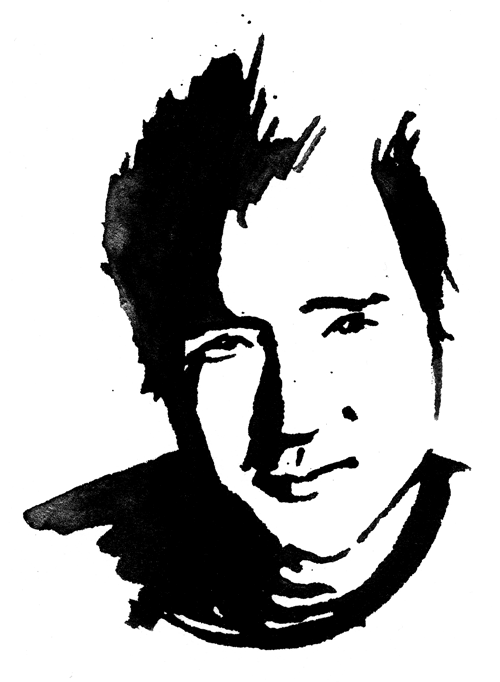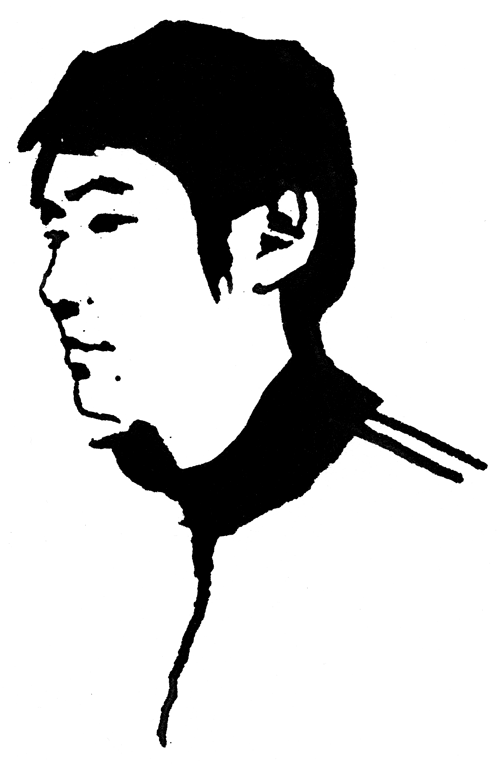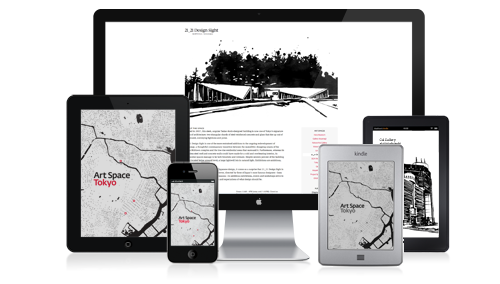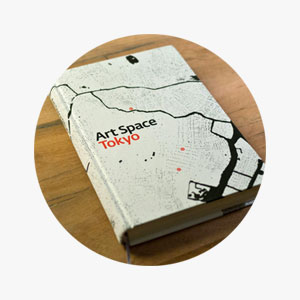Plugging into Public Space
An interview with Masato Nakamura & Shingo Suzuki
Project Space Kandada, Jinbocho / Kanda

MASATO NAKAMURA, director
Born in Akita in 1963. He graduated from Tokyo National University of Fine Arts and Music with a BFA in 1987 and and BFA in 1989. He now teaches there as an assistant professor. He formed the nonprofit art collective commandN in 1998. He has organized and exhibited in a diverse range of exhibitions, including Akihabara TV and the 49th Venice Biennale in 2001.
SHINGO SUZUKI, artist
Born in Kanagawa Prefecture in 1966. Graduated from the Department of Graphic Design at Tama Art University. As a member of commandN, he is involved in running Project Space Kandada. His artwork deals with the relationship between society and the individual and has been included in exhibitions organized by commandN, such as Akihabara TV and Sukima Project.

How did commandN begin?
MNThe starting point came in 1997, when I returned to Tokyo after having been in Hong Kong for ten months. That year I participated in the Sleeping Beauty exhibition at the Ueno Royal Museum, where I had the opportunity to interview a lot of people. The conversations we had got me thinking about the Tokyo art scene and how artists can engage with the city.
At that stage I already had Akihabara in mind as a place to work. I had this image of doing a project called Akihabara TV in which we would take over all the video and TV monitors in the area. It was in considering who to collaborate with that I spoke to Shingo about it, and around five or so people joined us at that stage. I found a property that would work very well as our base of operations, smack bang in the middle of Akihabara in Suehirocho, behind what is now Rensei Junior High School.
That place was so dirty that we had to put a lot of effort into cleaning it. Through the process of renovating the space and creating the gallery, we formed a sort of unity or collective consciousness, which I wanted to give a name to. I had this image of leaping forward, and that’s where commandN came from — you press ‘command’ and ‘N’ on your computer keyboard and a new window opens. The name primarily refers to this ongoing collective of people, but since the space we were working in at the time was so small — no more than the size of a single parking space — we called it commandN Cube.
What was the idea behind Akihabara TV?
MNThe original idea came to me while I was in South Korea in 1995. There’s a market in the Cheonggyecheon area of Seoul that is basically the Akihabara of Seoul; it looks like something out of Blade Runner. One day they were showing an NHK broadcast of a sumo tournament on one of the TVs there. It was being shown live, but occasionally the image would get interrupted or go fuzzy. When I saw that, I noticed that the hardware and the broadcasted image were out of synch. I had thought that all images being shown on TV were protected by law and maintained properly as legitimate television, but you can receive the same signals in neighboring countries too. Realizing that there’s actually quite a lot of freedom with that kind of technology, I thought it would be interesting to take over TV monitors in an electric town like Akihabara or Cheonggyecheon and install images we created ourselves. By changing the images being displayed on all this hardware, you could completely transform the town. The first Akihabara TV took place in 1999.1
The logistics of making such a project happen must have been incredibly difficult. How did the electric companies react when you approached them about it?
MNIt wasn’t good. There’s a labor union called Akihabara Electrical Town Organization, which consists of the directors of about four hundred stores in Akihabara. They were skeptical at first. But we managed to do a presentation in which we introduced the work of a variety of artists who were committed to Tokyo and who we thought were interesting.
However, just getting that presentation together at a technical level was really hard to pull off. For the first installment of Akihabara TV, we were using really cumbersome analog methods to edit our videos: we rented a stack of video decks and started to copy the artworks to VHS cassettes, but later when we checked, we found none of them had actually copied properly! I had to start all over.
By the second time around,2 people had begun to understand how interesting the project was, and we were able to attract more money. So we decided to give the project a more international vibe and asked some foreign curators to collaborate and recommend artists to us.
How did you go from being based in Akihabara to opening Project Space Kandada in Kanda?
MNAfter commandN Cube, in 2000 we did a project in which we moved our office and gallery space into SCAI The Bathhouse for three weeks. Making that move was a lot of hard work. After that we moved to a building called House Akihabara back in Akihabara, where the Laox computer store building is now. From 2002 there was a oneor two-year hiatus during which we didn’t own a space and I answered calls in my own office. We then moved to this current location in September 2005.
How come you kept moving from space to space?
MNRent was a factor, but more importantly it was also a problem of people’s attitudes towards our projects. We were gradually beginning to be seen as this alternative space, and a lot of people came to us with proposals and artworks, which made us more and more dependent on the gallery space. We were beginning to get tired of this dependency. Plus, the building was owned by Chiyoda Ward, meaning that people perceived us as this artist group that worked for free. That’s not a bad thing, but at one point it felt like we were a division of the municipal ward. We removed ourselves from that as a way of regenerating.
Why did you choose to run commandN as a nonprofit organization?
MNWhether we were operating in public or private spaces, our concepts and aims were always fundamentally about art and culture, and like Akihabara TV, a lot of our projects were very open to the public. In this light, I felt it was better for the projects not to be commercial. Of course, as an independent artist I make artwork for money but I also thought that it was very important to present the function of art in the city through working as a group and not for individual profit. Whatever project commandN works on, it’s about a variety of artists presenting their work in the same conditions on equal terms rather than in a hierarchical structure.
What do you think commandN’s role or function is in the Tokyo art scene?
MNI think it’s important to question what people define as the ‘art scene’ — is it based on galleries and museums? I think people perceive the art scene mostly in terms of finished artworks, which is usually all they are able to see. The process of the artwork’s creation and the artist’s agonizing is rarely ever exposed, so I felt it was necessary not just to show artists’ work but also to create a place where students and the other people who create the art scene can get together. It’s in circumstances like this that something ‘real’ is bound to happen. We need to reestablish the art scene by including all those anxieties and mistakes. I held a lot of guerilla exhibitions and so on in the early 1990s and through those experiences I’ve thought a lot about what it is to rebel against the art scene. I realized that the goal is not to climb up the preexisting structures, but to develop the art scene with your own hands. Of course there are times when this doesn’t work, but I think that we should accept commandN as a succession of those concepts that don’t necessarily work every time. We hold very experimental exhibitions, and a lot of artists have grown from that.
SSI agree. Masato invited me to join commandN when I was working by myself after graduating from school. When I decided that I wanted to make art and enter the art world, I didn’t have a clue what to do — should I go around galleries or museums? Were there any cafés where people like me would gather, anywhere where I could meet likeminded people and hear interesting stories? When Masato invited me, I had this hunch that a lot of people — not just artists — would probably join this project to exchange information and create a movement together. Members of commandN view their collective role as that of a hub that connects two or more things or places together. You can meet artists and people from other genres through us. We’re basically playing a similar role to that of galleries and museums but showing that they aren’t the only entities that can achieve this.
What do you consider to be a successful project or exhibition?
MNWith museums, I think that it depends a lot on the project itself and which artists have been chosen. With us, of course what we show is very important too, but the process of thinking about how to create art with other people is considerably more significant than the actual act of showing artworks. A successful exhibition isn’t just about the number of visitors. For Akihabara TV, a lot of people came because it was in a public area. We brought a lot of people together, which made it an extremely effective project in terms of our initial role of being a hub. More recently, we’ve been taking our projects to obsolete towns with the aim of stimulating regeneration, and this in turn helps creativity flow back to the residents. We’re trying to give back to towns and cities through our artwork. Success isn’t when an artist exhibits a good piece of work; it’s when voluntary ideas and creativity are given the opportunity to grow.
SSOur goal isn’t to draw in customers and sell work. It’s to try to effect some sort of change through our exhibitions or projects, something that should endure beyond the end of the exhibition. People will look at the work, and hopefully it will change the way they think, or lead them to take some sort of action. Unless an artist’s exhibition leads to a next step, I don’t think there’s any point in producing art.
Do you receive any financial support from the Tokyo government to realize your projects and exhibitions?
MNOur space is made possible through support from the government, other foundations and the owners of this building, and although it’s not much, it’s enough to run this organization. However, we’re now at a stage where we have to think more about how to raise funds by ourselves. The issue is how this organization can survive by getting a certain amount of profit while also maintaining the quality of our work, which is essential. Usually people involved in group activities like us only survive for about two or three years; they are really passionate in their twenties but by their mid-thirties they get tired and focus on how to support themselves financially.
The activities you carry out in public space are fairly rare for contemporary Tokyo; decades ago there used to be much more artistic interaction with public space, whereas there is barely any now. What do you think has changed?
MNI think the 1950s and ’60s were an era in which art became completely in synch with society’s feelings of rebellion against the system, whereas now there isn’t that clear focus of resistance. So-called avant-garde people in the 1950s were walking down the streets with mohicans, but people do the same thing today as a fashion statement.
This process of generalization has also applied to the way society makes urban space itself, and the service sector as well, especially in areas such as nursing care. Elderly people lie in the interior, private space of their bedrooms at home, but then the nurses will come to their houses and enter those private spaces; these days there are many services like this that consist of outsiders entering private homes. Of course, this phenomenon isn’t limited to Japan, but I find it interesting to consider contemporary Tokyo in terms of the ‘surface’ and the ‘interior.’ For example in Akihabara, even though you are outside you can identify what kind of shops are on each floor of a building simply from all the signs stuck on its façade. In places like Akihabara, interior space is clearly evident from the outside, whereas if you’re in Otemachi looking at a glass-covered building, you have no idea what’s inside. The strength of boundaries between interior and exterior space has always varied, but over the last few years these boundaries have blurred.
How do you think the Tokyo art world has changed in the past fifteen years?
MNBefore the widespread emergence of commercial galleries, the gallery scene in Tokyo mostly consisted of rental spaces, largely in Ginza. They’ve always been very expensive, although there was some variation in prices among them. In one sense, it’s good that rental galleries keep things relatively neutral and dependent only on the artist paying money, but generally speaking I don’t like how obvious the steps to success are: you rent out a gallery, do a show and then maybe you eventually get to exhibit at a museum. From the 1980s onwards, people in my generation gradually began to establish commercial galleries in areas other than Ginza; Tsutomu Ikeuchi’s Roentgen Kunst Institut was a highlight of the time. Many more interesting commercial galleries appeared in the 1990s, and galleries began to nurture artists rather than merely sell their work. Gradually, people have been using rental galleries less and less; they still exist, but not in the numbers they used to.
SSThere were hardly any alternative spaces when we started out, but now it feels like there are many more. Previously, artists would rent out galleries, but now I think that rather than saving money to do that, young artists should share a space together and try to rent out studios or even manage a space by themselves. This sort of self-motivated action is very evident these days.
MNIt’s fun to take risks and create something from scratch, rather than do something in a protected environment, right? It’s much more stimulating to create an alternative path by yourself. Unfortunately too many young people today think that success is a solo exhibition in a commercial gallery followed by showing their work at a museum. That’s not the be-all-and-end-all of art.

